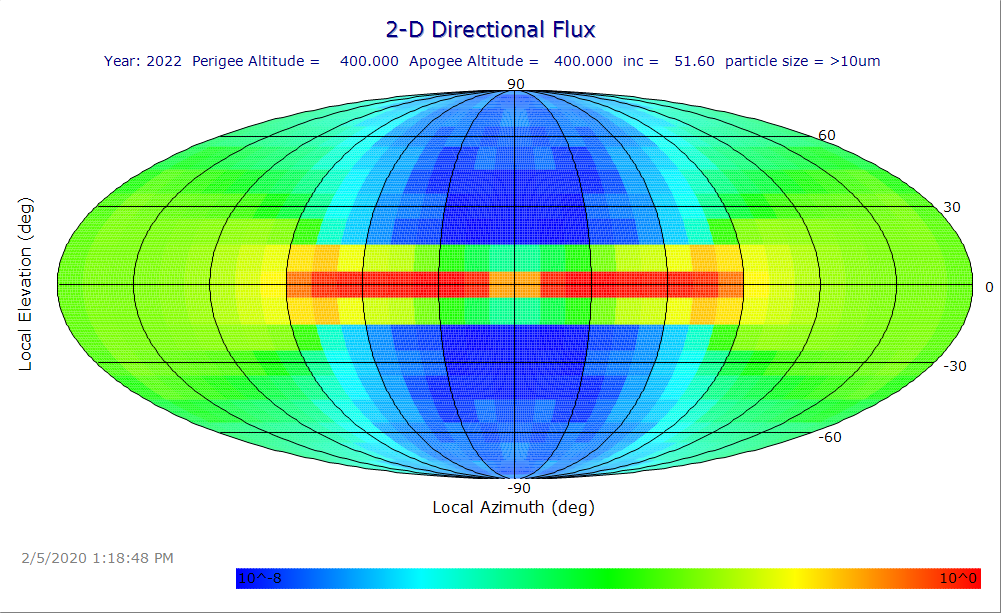ORDEM 3.2 : OD Engineering Model
The latest version of the NASA Orbital Debris Engineering Model, ORDEM 3.2, has been released. The model is appropriate for those engineering solutions requiring knowledge and estimates of the orbital debris environment (debris flux, impact directionality, etc.). ORDEM 3.2 can also be used as a benchmark for ground-based debris measurements and observations.
ORDEM 3.2 uses the same model framework as its predecessor, ORDEM 3.1, which was released in 2019. The model has been updated to include fragments from the Cosmos 1408 anti-satellite test conducted by the Russian Federation on 15 November 2021. The underlying populations from ORDEM 3.1 were maintained unchanged so these updates could be made quickly to reflect contributions from the event. The process to build and validate these underlying populations is described in detail in the ORDEM 3.1 Model Process and Model Verification and Validation reports.

ORDEM 3-dimensional average cross-sectional area flux for a spacecraft assessment, mapped to a 2-D directional flux projection. Hot colors indiciate areas of high flux while cool colors are areas of low flux. Direction relative to the spacecraft is noted in coordinates (local azimuth & elevation), where azimuth runs along the horizontal from left to right and ranges from -180° to 180° and elevation runs vertically from bottom to top and ranges from -90° to 90°. Credit: NASA ODPO.
The model incorporates the latest high-fidelity datasets, as well as advanced data analysis techniques to build and validate representative orbital debris populations encompassing low Earth orbit (LEO) to geosynchronous orbit (GEO) altitudes for the years 2016-2050.
Incorporated in ORDEM 3.2 is a large set of observational data (both in-situ and ground-based) that reflects the current debris environment. This data covers the object size range from 10 µm to 1 m. The orbital debris environment is dynamic and must be periodically updated. As newer datasets become available, they provide more information on the evolution of the orbital debris environment.
The model output lists debris fluxes in half-decade size bins by distinct material characteristics (i.e., intact objects, high-, medium-, or low-material density objects, and sodium-potassium [NaK] droplets) either by direction and velocity for an encompassing 'igloo' (for spacecraft) or by range bins (for a sensor beam on the Earth's surface), depending on the user's chosen operational mode.
The program graphical user interface (GUI), executable, data files, and a User's Guide are included in the package. ORDEM 3.2 has been subjected to extensive verification and validation. Currently, ORDEM 3.2 runs on Windows 10 and higher computers.
Although approved for public release, NASA regulations require that a software usage agreement must be obtained to acquire a copy of the NASA-developed software, ORDEM 3.2, MSC-25457-1. To begin the process, please press the "Request Software" button in the software catalog.
ORDEM is also available as a cloud-based application. The ORDEM web application includes the current features of the publicly released ORDEM software with an upgraded front-end design. The underlying ORDEM processor is run in the back-end API, allowing the user to run multiple spacecraft and telescope/radar mode tasks simultaneously. Some new ORDEM features are exclusive to the ORDEM web application, such as importing multiple TLEs, auto-generated plotting, and the ability to check runtime progress.
NASA users can access the ORDEM web application with Launchpad credentials. Non-NASA users can sign up for access by creating an account at https://guest.nasa.gov/. Once your account is approved, you will be able to access the new ORDEM web application.
ORDEM 3.2 was developed by the NASA Orbital Debris Program Office (ODPO) located at Johnson Space Center in Houston, TX. Funding for the ODPO comes from the NASA Office of Safety and Mission Assurance located at NASA Headquarters in Washington, D.C.